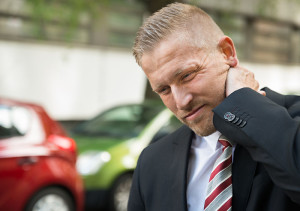
A recent research study has shown a possible correlation between hormone levels and a person’s level of recovery. Preliminary results show that information gathered from blood testing could gauge the degree of the injury and perhaps estimate the amount of time necessary to recover. The information gathered from this study is being looked at as a first step in the process of developing a means to determine objectively when an athlete is fit to return to play after sustaining a traumatic head injury.
To learn more about the connection between head and neck injuries and chronic neck pain, download our complimentary e-book by clicking the image below.
There are instances when concussion symptoms linger on long past the point when they should have dissipated. This is a condition known as post-concussion syndrome. For an injury to have been traumatic enough to cause a concussion, damage to the neck should be explored as a possibility as well. The vertebrae that sit just beneath the skull are especially prone to misalignment because of their unique shape and biomechanics. Concussion patients, especially those with lingering symptoms, must have misalignments in this area corrected in order to heal.
We see many patients in our offices after a head injury, and we are able to help them safely, gently, and naturally. Rather than just medicating the individual symptoms, upper cervical chiropractic identifies the root cause of the issue and works towards correcting it through specifically applied adjustments. By restoring the alignment of these vertebrae to normal, it also allows for normal blood flow, cerebrospinal fluid flow, and neurological function to return.
References:
http://www.mayoclinic.org/diseases-conditions/concussion/basics/definition/con-20019272
https://www.shu.edu/news/potential-hormonal-marker-for-concussion.cfm
To schedule a complimentary consultation with Dr. Crowder, call our McKinney office at 972-449-5845. You can also click the button below.

If you are outside of the local area, you can find an Upper Cervical Doctor near you at www.uppercervicalawareness.com.

A person with a concussion may have a headache or feel pressure in the head. They may also feel dizzy, nauseated, and extremely tired. In some cases, there may be ringing in the ears, problems with speech, and cognitive deficits as well. Some symptoms may not appear for days or even weeks after, including problems with memory, sleep issues, depression, anxiety, or personality changes.
To learn more about the connection between head and neck injuries and chronic neck pain, download our complimentary e-book by clicking the image below.
When someone sustains a blow to the head bad enough to cause a concussion, the odds are they’ve also injured the neck as well. Upper cervical expert Dr. Terry Crowder sees this all the time in his practice; his patients who come in after a concussion often have a very specific misalignment of the vertebra that sits just beneath the skull at the top of the neck. This vertebra is responsible for holding the head up, so it makes sense that after a blow to the head, this small bone can be easily forced out of position. This can be the culprit for lingering concussion symptoms, especially headaches.
If you’ve suffered a concussion, having your upper cervical spine examined for a misalignment is key for ensuring proper healing. Dr. Crowder will perform a thorough analysis to determine if this misalignment is present and will then customize a plan of care to correct the issue. Many people with persistent will finally find the lasting relief they’ve been seeking.
Reference:
http://www.webmd.com/brain/concussion-traumatic-brain-injury-symptoms-causes-treatments
To schedule a complimentary consultation with Dr. Crowder, call our McKinney office at 972-449-5845. You can also click the button below.

If you are outside of the local area, you can find an Upper Cervical Doctor near you at www.uppercervicalawareness.com.

It may originate from either the structure of the neck (your spinal column and vertebrae) or the soft tissues (your muscles, ligaments, and tendons). Of course, it is all connected, making the source of neck pain difficult to pinpoint at times. Most people don’t think about the importance of neck strength like they do the strengthening of the biceps or quadriceps. However, neck weakness can become a big issue and a key piece of maintaining normal function of brain-body communication.
To learn more about the connection between head and neck injuries and chronic neck pain, download our complimentary e-book by clicking the image below.
While strengthening the muscles of the neck is definitely important, if the structure of the neck is abnormal or misaligned, no amount of strength will provide lasting relief of neck pain. Upper cervical chiropractor Dr. Terry Crowder focuses his entire practice around making sure the vertebrae of the neck are aligned properly. More specifically, the top two vertebrae of the neck are the keystone of the spine and when misaligned can create pain and loss of function anywhere in the body. So, if you haven’t found lasting relief from your neck pain from ice, heat, massage therapy, painkillers, or otherwise, a misalignment of the upper cervical vertebrae of the neck should be investigated as a probable cause of your pain.
References:
http://breakingmuscle.com/strength-conditioning/the-top-5-exercises-to-strengthen-your-neck
To schedule a complimentary consultation with Dr. Crowder, call our McKinney office at 972-449-5845. You can also click the button below.

If you are outside of the local area, you can find an Upper Cervical Doctor near you at www.uppercervicalawareness.com.

The neck can be a very vulnerable part of the body. After all, it carries the weight of the heads, which can range from 10 to 12 pounds. A neck can be injured in car accidents, sports traumas, and even by spending too much time buried in our mobile devices texting.
To learn more about the connection between head and neck injuries and chronic neck pain, download our complimentary e-book by clicking the image below.
A recent article describes a surgical procedure that looks towards the nerves as the source of neck pain. During this surgery, patients are partially awake while the doctor touches different nerves in the neck trying to locate the source of the pain so that it can be addressed. While those doctors are on the right track thinking that nerves can be the source of neck pain, a natural, more conservative option is available and achieves results without having to go under the knife.
In McKinney, TX, neck pain expert Dr. Terry Crowder’s goal is to correct the cause of his patient’s neck pain naturally. Dr. Crowder focuses specifically on the top two vertebrae in the neck, since their unique shape and design can cause them to misalign easier than the other bones of the spine. A misalignment in this area is frequently the culprit of chronic neck pain, and it must be corrected in order to start on the road to recovery. Dr. Crowder’s adjustments are gentle, specific, and given only when necessary to ensure that the maximum amount of healing can occur.
References
http://www.wndu.com/home/headlines/Neck-pain-caused--338052422.html
To schedule a complimentary consultation with Dr. Crowder, call our McKinney office at 972-449-5845. You can also click the button below.

If you are outside of the local area, you can find an Upper Cervical Doctor near you at www.uppercervicalawareness.com.

To learn more about the connection between head and neck injuries and chronic neck pain, download our complimentary e-book by clicking the image below.
Many people never receive treatment for whiplash injuries, relying on rest, over the counter medications, and home remedies. While this may serve as a short-term solution to the pain and discomfort, the problem lies in the fact that the underlying structure of the spine was never addressed. The whiplash injury may likely have caused specific misalignments of the vertebrae in the neck that are often the cause of lingering pain, even after a minor accident.
Neck pain expert Dr. Terry Crowder helps patients suffering from whiplash injuries both old and new. As an upper cervical chiropractor, Dr. Crowder looks for misalignments in the top two vertebrae in the neck, which are usually the culprit in patients with long-standing neck pain following an injury.
Dr. Crowder’s adjustments are gentle and specific. By restoring normal alignment and biomechanics to the vertebrae in the neck, the soft tissues are also allowed to heal normally as well. That is why many whiplash patients are able to find lasting relief without having to rely on medications.
To schedule a complimentary consultation with Dr. Crowder, call our McKinney office at 972-449-5845. You can also click the button below.

If you are outside of the local area, you can find an Upper Cervical Doctor near you at www.uppercervicalawareness.com.

Regardless of the combination of symptoms a person may experience, the effects of a concussion can be expected to last a few days to a few weeks and then start to improve. Recovery is typically the quickest in the first few weeks following the injury, but the repair process actually continues for many months. When those intense initial symptoms fail to go away after three months or so, a person is typically diagnosed with post-concussion syndrome.
To learn more about the connection between head and neck injuries and chronic neck pain, download our complimentary e-book by clicking the image below.
Researchers still have not determined the exact reason why some people who have had concussions will develop symptoms that don’t go away, while others recovery quickly. There also doesn’t appear to be a relationship between the severity of the head trauma and the risk of developing post-concussion syndrome – meaning that even the mildest of head traumas can cause it.
One thing all concussion cases share in common is their origin – a traumatic brain injury – no matter how mild or severe. An important yet often overlooked factor is the structure of the neck. During an injury, it is likely that the alignment of the vertebrae in the neck is adversely affected. This is an issue that must be addressed for normal healing to take place.
In Dr. Crowder’s upper cervical chiropractic practice, patients who have experienced a concussion are able to correct the root cause of many of their post-concussion symptoms. Dr. Crowder looks for specific misalignments of the top two vertebrae in the neck that are preventing the body’s natural healing process from taking place. When those vertebrae are out of alignment, they put pressure on the brainstem, causing dysfunction in the messages sent between the brain and the body. Dr. Crowder works with his concussion patients to restore normal alignment, allowing normal function to return as well. This provides relief to people whose post-concussion syndrome symptoms have gone on for far too long.
To schedule a complimentary consultation with Dr. Crowder, call our McKinney office at 972-449-5845. You can also click the button below.

If you are outside of the local area, you can find an Upper Cervical Doctor near you at www.uppercervicalawareness.com.

To learn more about the connection between head and neck injuries and chronic neck pain, download our complimentary e-book by clicking the image below.
Even if pain is not felt right away, or if it is mild, there is still a chance that the underlying tissues and vertebrae were affected. In McKinney, TX, Dr. Terry Crowder takes a unique but effective approach to helping people break through the cycle of pain following a whiplash injury. As an upper cervical chiropractor, Dr. Crowder looks for the root cause of the lasting pain. Typically, that root cause is coming from a misalignment of the top bones in the neck that may have occurred as a result of the whiplash injury. Dr. Crowder’s care is aimed at correcting that misalignment to restore normal biomechanics and function to the neck and nervous system, so that the body is able to heal optimally following an injury.
References:
https://www.rush.edu/health-wellness/discover-health/5-facts-about-whiplash
To schedule a complimentary consultation with Dr. Crowder, call our McKinney office at 972-449-5845. You can also click the button below.

If you are outside of the local area, you can find an Upper Cervical Doctor near you at www.uppercervicalawareness.com.

Oftentimes, people wake up with a stiff neck and think that they must have slept “funny”, or that they need a new pillow. Sleeping position can definitely have an impact on the health and stability of the neck. Stomach sleeping puts a lot of stress and strain on the joints and soft tissues of the neck, since the head is rotated to one side or the other for an extended period of time. Back and side sleeping positions are preferred since they keep the head and neck in a more neutral position.
To learn more about the connection between head and neck injuries and chronic neck pain, download our complimentary e-book by clicking the image below.
Among the seven vertebrae that make up the cervical spine, the top two bones (C1 & C2) are unique for several reasons. There is no disc separating the two, and they lack the locking joints of their counterparts below. This makes them especially vulnerable to injury or misalignment, and a likely culprit in many neck pain cases.
Dr. Terry Crowder focuses his attention on these top two bones in his upper cervical chiropractic practice. Since these bones are so unique, Dr. Crowder does a very specific analysis so that when an adjustment is made to realign these bones, it is tailor-made for that particular patient.
Rather than continuing to treat neck pain with over-the-counter pain medications or anti-inflammatories, Dr. Crowder is able to help people by directing their spines towards more normal alignment. This not only reduces stress on the joints and soft tissues of the spine, but also allows the nervous system (protected by the spine) to function unobstructed.
References:
http://www.gallup.com/poll/154169/Chronic-Pain-Rates-Shoot-Until-Americans-Reach-Late-50s.aspx?ref=image
http://www.health.harvard.edu/pain/say-good-night-to-neck-pain
To schedule a complimentary consultation with Dr. Crowder, call our McKinney office at 972-449-5845. You can also click the button below.

If you are outside of the local area, you can find an Upper Cervical Doctor near you at www.uppercervicalawareness.com.

Whiplash is an injury to the tissues of the neck as a result of the head going into sudden extension and flexion, as commonly seen in car accidents or sports injuries. Intervertebral joints, discs, ligaments, muscles and nerves can all sustain damage as a result of a whiplash injury. This can lead to a host of symptoms, the most obvious of which is neck pain. The neck pain can develop directly after the incident, or it can even be delayed for several days. In addition to neck pain, people with whiplash injuries often experience headaches, dizziness, cognitive issues, and sleep disturbances as well.2
The most common approach to whiplash relief care includes medications to address the pain, inflammation, and muscle spasm. The neck is sometimes immobilized for 2 to 3 weeks with a cervical collar.2 Physical therapy, range of motion exercises, and cervical traction may also be recommended.
To learn more about the connection between head and neck injuries and chronic neck pain, download our complimentary e-book by clicking the image below.
Failure to check the underlying spinal structure for any misalignments, or subluxations, that may have occurred as a result of the accident. In his McKinney, TX upper cervical chiropractic clinic, neck pain expert Dr. Terry Crowder analyses the alignment of the vertebrae of the neck, particularly of the upper 2 bones. A misalignment in this area can disturb normal neurological function, which may obstruct or delay the normal healing process. By gently realigning the top two vertebrae in the neck, the rest of the affected tissues are able to begin to heal naturally. An upper cervical check-up is an important step for people recovering from a whiplash injury. Without normal alignment of the underlying structure, the rest of the structures of the neck are unable to heal fully and properly.
REFERENCES:
To schedule a complimentary consultation with Dr. Crowder, call our McKinney office at 972-449-5845. You can also click the button below.

If you are outside of the local area, you can find an Upper Cervical Doctor near you at www.uppercervicalawareness.com.

In a comprehensive study done in 2006 of 60 patients, 56 (93%) recalled a history of trauma. These traumas ranged anywhere from a severe auto accident, a mild slip on the sidewalk, bicycling accident, skiing accident, horseback riding, etc. There were only four people of the 60 that didn’t have or couldn’t recall any traumatic incident prior to the onset of their vertigo symptoms.2
Since there appears to be such a high correlation between dizziness symptoms and head injury, no matter how mild you think the injury may have been, it is critical to verify that your spinal alignment has not been compromised. The vertebrae of the neck, particularly the top two, are very vulnerable to misalignments due to their unique shape. The atlas (C1) and axis (C2) vertebrae are responsible for the majority of head and neck movement. A misalignment, or subluxation, in this area must be assessed by an upper cervical specific chiropractor in order to make a determination that this could be the root cause of your vertigo.
To learn more about the connection between head and neck injuries and chronic neck pain, download our complimentary e-book by clicking the image below.
Dr. Crowder, a vertigo and dizziness expert in McKinney, TX, has been specifically trained to analyze for and correct misalignments of the C1 and C2 vertebrae. Using sophisticated diagnostic imagining and other tools, Dr. Crowder is able to determine the exact nature of the upper cervical misalignment, make the necessary correction, and allow the body’s natural recuperative processes to take place. Removing the interference from the communication between the brain and nervous system to all areas of the body can help to alleviate vertigo symptoms by allowing proper communication between the sensory systems of the body and the brain. In the study mentioned earlier on in this post, a vertigo sufferer of 37 years was able to regain a symptom-free life after only one month of upper cervical care!2
REFERENCES:
To schedule a complimentary consultation with Dr. Crowder, call our McKinney office at 972-449-5845. You can also click the button below.

If you are outside of the local area, you can find an Upper Cervical Doctor near you at www.uppercervicalawareness.com.